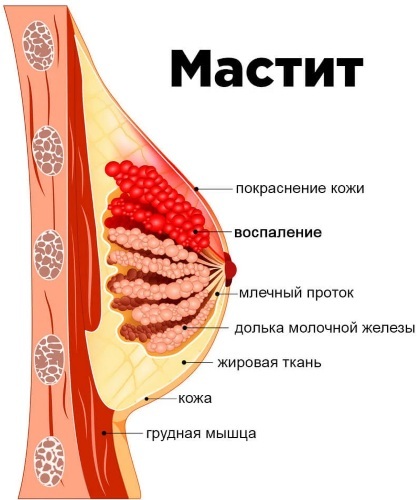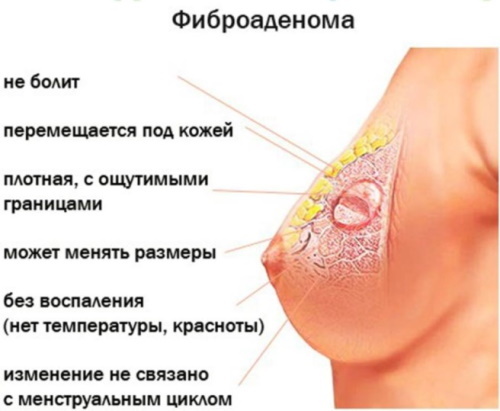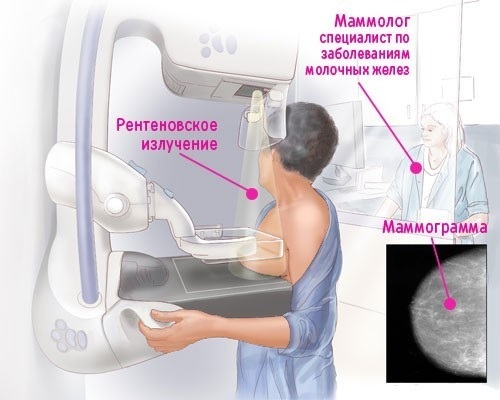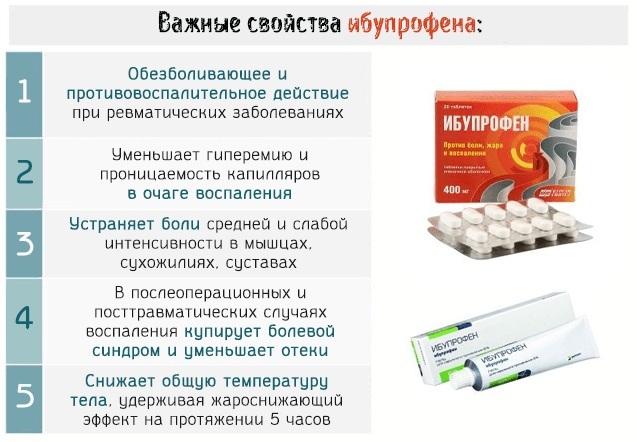When the woman's breasts are swollen and fluid is released from the glands, you should pay close attention to this. Especially if it is during menopause. This symptom can signal negative processes in the body or be a harbinger of a complex disease.
Record content:
- 1 Potential danger
-
2 Causal factors
- 2.1 Physiological
- 2.2 Benign
- 2.3 Malignant
- 3 Who to contact
- 4 Diagnostic methods
- 5 Video on nipple discharge
Potential danger
Discharge may be normal when a woman is pregnant or breastfeeding. In other situations, it is recommended to consult a doctor. Perhaps this is an injury that was received from a fall or impact. To understand this, you need to conduct an examination by making an appointment with a mammologist.
You should be especially careful if the oozing liquid:
- has a gel-like consistency;
- with the inclusion of blood particles;
- has an unpleasant odor.
Discharge from the mammary glands can disturb women before the onset of menopause. In isolated cases, breast oncology manifests itself in this way, therefore experts recommend taking such symptoms seriously.
There are the following types of discharge:
| Discharge type | Description |
| Milk-curdled | It can be classified as frequent. It is usually associated with the cessation of breastfeeding or the onset of hormonal changes before the climatic period. |
| Bloody | They are caused by non-oncological tumors, such as the papilloma formed inside the gland. It irritates the tissues responsible for the milk flow. There is also a possibility that such a manifestation indicates a malignant tumor. |
| Colorless | Often signaling breast cancer |
| Greenish | This color of the discharge indicates that there is a cyst under the areola. |
The texture of the liquid is also different:
- thick;
- sticky;
- stretching.
In this case, the course often occurs involuntarily, sometimes the secret appears when pressing on the chest or nipple. In some periods of time, the secretion increases or decreases.

In addition to the liquid from the nipples, the following discomfort is possible:
- pain in the problem area;
- the formation of lumps from the liquid;
- the appearance of swelling of the breast or nipple area;
- change in swelling of the skin of the chest;
- the appearance of redness, itching and flaking;
- change in the size of problem breasts: one breast becomes larger or smaller than the other;
- nausea, vomiting;
- cessation of menstruation or failure of the cycle;
- feeling of constant tiredness.
Causal factors
Discharge from the mammary glands during menopause can have various causes. It is common for the baby to end feeding.
Other unpleasant reasons include:
- abscess. If a local inflammatory focus has formed in the tissues, its symptoms, in addition to the flow from the nipples, will be high fever, swelling and pain. The problem is solved surgically, by taking antibiotics prescribed by a doctor;

- hormonal disorders. Endocrine system problems begin with the failure of the usual menstrual cycle. In addition, profuse bleeding and discharge from the chest appear;
- strong stimulation of the nipple area;
- a cyst inside the chest;
- trauma to the chest area;
- ectasia of the milk passages;
- mastitis;
- hormonal disorders caused by a pituitary tumor.
Also such symptoms may be a consequence of the reception:
- drugs to lower blood pressure;
- antipsychotic drugs;
- strong antidepressants and sedatives;
- narcotic ingredients such as cocaine or marijuana.
Experts identify 3 groups of main causes of nipple discharge
They may be:
- physiological;
- benign (not oncogenic);
- malignant (oncological).
Physiological
They arise for natural reasons: their need is dictated by the natural desire of a woman to conceive a child and breastfeed him. After giving birth, a woman's breasts begin to produce milk and colostrum. They are necessary for feeding the child and strengthening his immune system, protection against allergies, diathesis.
Discharge that is transparent in color and is not associated with the birth and rearing of offspring can be caused by taking medications.
Benign
They are not deadly, but they can bring a lot of trouble in the future.
Benign disorders can trigger the occurrence of:
- fibrocystic neoplasms;
- formations in the tissues of the mammary glands of papillomas that grow into the intraductal vessels. They are similar to polyps;
- mastitis;
- fibroadenomas of the breast;

- benign nipple adenoma;
- ductal hyperplasia. This is a strong thickening of the walls of the ducts.
In addition, eczema, atopic dermatitis can be the reason for the discharge of fluid from the nipples.
Among physicians, it is customary to distinguish several signs accompanying these pathologies:
- frequent bilateral secretions;
- the flow of fluid increases or becomes more intense with strong squeezing of the nipple;
- light or greenish discharge;
- discharge of a sticky consistency.
Malignant
A group that suggests the presence of cancer cells or a precancerous condition in a woman.
Namely:
- ductal hyperplasia (atypical). It appears when ductal hyperplasia is not treated and the degree of coarsening of the alveoli begins to exceed the critical mark. As a result, precancerous changes begin to occur in the body;
- carcinoma. Appears on the surface of the walls of the ducts as a neoplasm;
- Paget's disease;
- invasion of duct carcinoma. This is a malignant tumor in nature. It grows into breast tissue and lymph.
In the malignant form, the following problems stand out:
- the flow of a one-sided plan;
- spontaneous flow without any pressure on the chest;
- the color of the liquid can vary from pinkish to black with bloody spots inside;
- an increase in lymph nodes in the armpit and a feeling of extraneous nodes inside the glands themselves.
Most often, the following relationship is observed between the causes and the color of the discharge:
- liquid of white, yellow or green shades indicates the presence of inflammatory processes, for example, mastitis;
- dark green, thick streaks from the chest indicate the presence of ductal cysts and suppuration in them;
- a brown secret is characteristic of ectasia;
- transparent and watery drops appearing from the nipples indicate the beginning of the development of cancer cells;
- ichor says that there is a papilloma inside the milk streams.
Who to contact
Discharge from the mammary glands with menopause requires clarification of the cause.
A mandatory visit to a doctor is necessary if:
- there were cases of cancer in the family;
- the structure of the discharge is colorless with blood;
- nodular lumps are felt inside the breast.
Every woman should monitor her health and periodically examine the mammary glands on her own. If fluid appears from the nipples or lumps, you need to visit a mammologist or gynecologist. The doctor must identify the causes of the problem, diagnose and prescribe therapy.
This requires the following laboratory tests:
- tests for the level of prolactin. This hormone is responsible for the production of milk in the breast. Studies will exclude the presence of a pituitary tumor;
- thyroid-stimulating hormone. It is produced by the pituitary gland to regulate the thyroid gland. The analysis should exclude its deficiency (hypothyroidism);
- chronic gonadotropin;
- pregnancy test.
If oncology is suspected, the doctor additionally prescribes a complex of cytological studies of the fluid secreted from the glands. This is necessary to determine if it contains cancer cells. However, even this study does not give a complete picture and can reveal a tumor in its initial stage.
For Paget's cancer, a skin biopsy of the nipple and halo area is done.
In addition to the yellow discharge, in this case, the following should be present:
- peeling of the skin;
- eczema lesion;
- itching.
A puncture biopsy will help confirm or deny the diagnosis.
Diagnostic methods
Discharge from the mammary glands with menopause can be diagnosed by the following research methods:
| Study | Description |
| Mammography |
 This is a study of the mammary glands using an X-ray, which allows you to identify existing seals and other anomalies in women aged 35 and above. It helps to see the beginning of the development of cancer cells if the examination is carried out in a timely manner. This is a study of the mammary glands using an X-ray, which allows you to identify existing seals and other anomalies in women aged 35 and above. It helps to see the beginning of the development of cancer cells if the examination is carried out in a timely manner. |
| Ultrasound | It is prescribed for younger women (up to 35 years old). This is how cystic seals are detected. |
| Ductography | Necessary for examining the ducts of the mammary gland. Before the procedure, the patient is injected with a contrast agent. Allows you to identify the presence of tumors with an exact size and location inside the breast |
| MRI (magnetic resonance imaging) | It makes it possible to see small seals inside the body and at the same time is practically safe for humans. However, there are sometimes false positive results, so such studies are prescribed not too often. |
Gynecologists advise doing research at least 2-3 times a year. If there are chronic diseases, you can come to the appointment in 2-3 months to monitor how the state of the mammary glands is changing. This will allow you to notice in time the changes that have begun and unfavorable signs signaling the diseases associated with them.
Women who have entered the climacteric period, which occurs between the ages of 45 and 55, should visit their doctor more often. This will reduce the likelihood of the formation of pathologies. In addition, the doctor will help you to survive the difficult period of life less painfully.
During examinations and examinations, the likelihood of detecting oncological diseases at their early stage increases. After all, the body at this time is being rebuilt and it means it is easy to miss the moment of the onset of symptoms that indicate pathology.
It is important to understand in which cases it is imperative to see a doctor.
Namely:
- discoloration of the nipples;
- detection of nodules or swelling;
- enlargement of the nipples;
- decreased appetite;
- apathy.
To make life comfortable during menopause, to remove or minimize pain in breast, the following preventive measures must be taken:
- exclude or reduce the amount of fatty and fried foods in the diet;
- give up sweets;
- do not drink alcohol;
- quit smoking;
- increase the amount of dairy products in the diet;
- there is only boiled and low-fat meat;
- lead an active life, doing fitness, walking in the fresh air.
In addition to a supportive diet, you should strictly follow the schedule for taking the drugs prescribed by the doctor.
The onset of menopause for many women is very stressful and in order to understand that life is still good, you need to monitor your health, more often be examined and, if such unpleasant symptoms as discharge from the mammary glands appear, do not panic, but find out what it is connected with and decide problem.
Video on nipple discharge
Doctor about nipple discharge:



